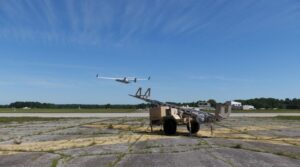The Navy conducted the first flight test of the Guardian detect and avoidance system as it seeks to make manned/unmanned teaming safer ahead of tests with the MQ-25A Stingray unmanned tanker.
The service said Guardian will work by tracking manned and unmanned systems across a 200 nautical mile radius airspace via ground-based sensors. The system then provides visual cues to unmanned air vehicle operators in ground control stations for navigation and traffic avoidance maneuvers when collisions are imminent.
In the first test at Naval Air Warfare Center Aircraft Division (NAWCAD) at Patuxent River, Md., on July 28,, operators flew two RQ-21 Blackjacks toward each other while Guardian operators monitored screens that displayed the approach as part of the test plan. Guardian alerted its operator of an imminent collision once the Blackjacks were within 400 feet of each other and made avoidance maneuver suggestions, the Navy said.

This initial test occurred on Aug. 8.
“Guardian is a technology that will safely enable manned/unmanned teaming. We’re starting at DoD test ranges, but every squadron or ship could integrate this system seamlessly for a safer air wing at sea or ashore,” Kris Melton, NAWCAD’s Guardian project lead, said in a statement.
Melton said his team is working to make sure Guardian is ready for incoming unmanned air systems, notably the aircraft carrier-based MQ-25A Stingray unmanned tanker unmanned aircraft.
“Our single priority is getting Guardian ready for the future of Naval and Marine Corps unmanned aviation. We’re training our test pilots and fine-tuning the tech during this demo to prepare for the new carrier based unmanned air system, MQ-25’s, arrival to Pax but Stingray is just the beginning,” Melton said.
Guardian was first developed for defense test ranges with the Army’s Redstone Test Center, and also has early interest from the Air Force. It is funded by the Office of the Secretary of Defense’s Test Resource Management Center and the MQ-25 Stingray program.
The Navy said the test team is aiming for technology adoption by the MQ-8 Fire Scout, MQ-4C Triton, and Small Tactical UAS programs for the future. It also intends to use Guardian to help the Navy prepare for the MQ-25’s arrival for developmental testing at Patuxent River.
NAWCAD engineers prototyped Guardian as a response to Federal Aviation Administration (FAA) mandated limited unmanned systems from operating in airspace alongside manned aircraft. The Navy said these restrictions make scheduling flight operations increasingly difficult as the service increases its fleet of unmanned aircraft.
Now NAWCAD says Guardian is the sole ground-based detect and avoidance system developed to meet FAA performance standards for unmanned systems. Naval Air Systems Command experts the system to be certified by the end of fiscal year 2023.
“Looking ahead, we’ll put Guardian through complex tests to confirm it will reliably handle congestion in the busiest airspaces as we work toward FAA certification, which could significantly reduce Stingray’s developmental test time and costs,” Lt. Cmdr. Alex Dulude, the Blackjack air vehicle operator supporting Guardian’s first flight, said in a statement.